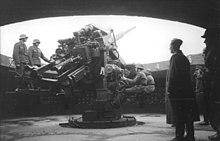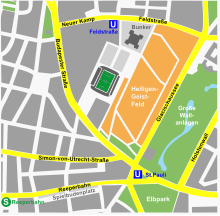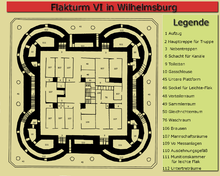Hamburg flak towers
The Hamburg flak towers are two large, concrete, steel-reinforced air defense and air protection structures in the Hamburg districts of St. Pauli and Wilhelmsburg . Originally , four towers were built during the Second World War , more precisely from 1942 to 1944, two of which were designed as bunkers with mounted anti-aircraft guns and two as smaller control centers. The towers could only partially meet the military requirements for a combat position; But they were all the more successful as a shelter for the population and in terms of propaganda because they were designed as almost indestructible fortresses . Because of their self-sufficient construction, they might have had a long-term defense against attacking ground troops. Of the four built towers, the two battle towers have been preserved.
history
In response to the Allied air raids on Berlin , the “ Führer order to erect flak towers in Berlin” was issued on September 9, 1940 , which was extended to the cities of Vienna and Hamburg by the end of 1942 in order to protect them from bombing raids. During the Second World War, Hamburg became the target of Allied air raids , among other things because there were several large shipyards in the city such as Blohm & Voss , Howaldtswerke , Deutsche Werft and HC Stülcken Sohn , which produced many of the German submarines. The flak towers were designed by the architect Friedrich Tamms under the direction of Albert Speer , the general building inspector for the Reich capital , and realized by the Todt organization , also with the use of thousands of foreign and forced laborers .
construction
For the airspace defense of Hamburg, three battle towers were planned, which were to be arranged in a triangular shape over the city area in order to ensure good coverage. The guide tower (L tower) belonging to each combat tower (G tower) was at least 100 meters away from it so that the vibrations and the thick smoke of the anti-aircraft muzzle flash did not affect the measuring devices used to determine the target. The L towers were designed to be narrower than the G towers and equipped with a wide variety of targeting, measuring and radar devices such as the Würzburg giant .
Of the three planned flak towers, only two were built. The third tower was to be built in the east of Hamburg, but this was not realized. The flak towers were numbered nationwide (Berlin, Hamburg and Vienna) according to the date on which construction began, so that the Hamburg towers were given the Roman numerals IV and VI.
The flak towers were designed as completely self-sufficient units with their own electricity and water supply and had a hospital. They were also protected against gas attacks by a slight overpressure inside the building.
Flakturm IV in St. Pauli (bunker on Feldstrasse)
Military use during World War II
The Flakturm IV in St. Pauli is located at the coordinates 53 ° 33 '23 " N , 9 ° 58' 12" E and belongs to type 1 . The bunker on Feldstrasse was built in 1942 by 1,000 forced laborers in 300 days. He was armed with four 10.5 cm anti-aircraft guns , which were replaced by four 12.8 cm Flakzwilling 40 in August 1942 . The Flakturm IV is one of the largest bunkers ever built. The base measures 75 meters by 75 meters and is 38 meters high. The wall thickness is 3.5 meters; the ceiling is five meters thick. Windows were built in and sealed with concrete seals. Although the capacity was limited to 18,000 people, up to 25,000 people sought protection in the bunker during the heavy air raids on Hamburg in the summer of 1943 . There was a special pram entrance for women with children. In the bunker there was a spiral staircase to the top, which initially had no handrail and was life-threatening in crowded conditions.
Civil re-use
Emergency shelter
The bunker Feldstrasse was used by civilian tenants after the war, as there was a great shortage of living space in Hamburg at that time. That is why the tower was prevented from being blown up in July 1947, and the required explosive force would probably have affected large parts of the city center. Corresponding experience was gained from comparable systems in Berlin. During the Cold War , the intact combat tower was reactivated as an air raid shelter.
Leasehold
In 1990 the building was sold for around 1.6 million DM and converted into a media center, which today houses the Uebel & Dangerous discotheque, among other things . In 1993, investor Prof. Thomas JC Matzen acquired the long-term lease for the bunker until 2053 for 6 million DM at that time. In the meantime, this long-term lease has been transferred to Matzen Immobilien GmbH. With a group of investors, the company applied to add five stories to the listed building with a height of around 20 meters. A hotel, a fitness club, restaurants, an event and sports hall are to be built. The investment also includes planting on the roof. The estimated investment costs of around 30 million euros are to be offset by commercial uses. After approval by the district office in Mitte, on July 12, 2017, the citizens also approved the building plans and the extension of the long-term lease with the votes of the SPD and the Greens.
The first of five floors to be added was concreted in June 2020. A lawsuit against the increase was dismissed in July 2020.
Increase and greening
In advance of these decisions, there was criticism of the plans presented. At the beginning of June 2017, construction plans were published according to which the often advertised green increase can only be realized in a significantly reduced manner due to fire protection requirements. The Left criticized the agreed conditions that instead of the actual land value of around 1,500 euros per square meter, only a value of just under 980 euros was calculated, plus a discount of 30 percent. In addition, a parking space fee of 744,000 euros was waived.
In May 2019, it became known that tenants in the bunker would suffer disadvantages as a result of the addition work.
Small anti-aircraft control tower demolished
In 1950, the Northwest German Broadcasting Corporation (NWDR) sent a first television test image from the associated smaller former anti-aircraft control tower on the southwestern edge of the Heiligengeistfeld (then Eimsbütteler Strasse; since 1956 Budapester Strasse ) . From December 25, 1952, together with the NWDR- Funkhaus Köln , which broadcast another program for a short time until 1953, a regular television program was broadcast from the bunker at Heiligengeistfeld (→ History of television in Germany ). The guide tower was completely demolished in 1973/74, except for parts of the foundation, to make way for an exchange for the Deutsche Bundespost .
Flakturm VI in Wilhelmsburg

The Flakturm VI in Wilhelmsburg is located at the coordinates 53 ° 30 '36 " N , 9 ° 59' 24" O . It was built according to type 2 and completed in October 1943. Around 80,000 cubic meters of reinforced concrete were only required for the construction of the battle tower. The still preserved battle tower has a floor space of 57 × 57 meters, a height of 41.6 meters, a wall thickness of at least 2 and a ceiling thickness of 3.5 meters. In contrast, the guiding tower was a lot smaller with a footprint of 39 × 23.5 meters and a height of 41.8 meters.
The four positions of the combat tower were equipped with 12.8 cm twin flak of the type Flak 40 (maximum firing range: 21 kilometers; maximum firing height: 15 kilometers) and were better protected than the positions of the type 1. The ammunition of the guns was on chain lifts brought the battle tower and stored there in niches that were arranged in a circle around the flak. In one hour, the four guns could fire around 2,900 shells, each weighing 26 kilograms. One floor under the roof were also 2 cm and 3.7 cm anti-aircraft guns for use against low- flying aircraft . The ammunition was stored on the ground floor; the replacement gun barrels in the basement.
In total, the flak tower comprised nine floors, part of which was intended as an air raid shelter for the population. Up to 30,000 people from the surrounding area sought protection in it. So that the military function was not impaired, there was a separate staircase for the soldiers and flak helpers .
The Luftwaffenhelfer Gustave Roosen described the situation as follows:
"Basically, it was no feat, it required empathy and instinct to balance the double pointers - setpoint / actual value - with the speed of rotation of the tracking pointer (identical to the speed of rotation of the gun) and to keep them exactly in line ('on cover'). You sat on a sheet metal seat, like on a tractor, in front of you the handwheel, behind it the large double pointer scale and the angle of the handwheel determined the rotational speed of the gun (or with the 'K2' the angle of attack); it was pleasant that everything worked hydraulically, in contrast to the 8.8 cm flak, which had to be adjusted with muscle power. [...] Here in Hamburg we were constantly busy - every evening around 8 p.m., you could set the clock afterwards, full alarm. Bomber groups on their way to Berlin used the Elbe estuary and the Elbe as an approach lane. Of course, Hamburg, the port, the oil tanks and refineries in Harburg and Wilhelmsburg were constantly the target of their massive attacks. There were infernal combat situations but - here in particular - you had the feeling of being able to defend yourself [...] The flak tower batteries, including those in Wilhelmsburg, consisted of two towers - the gun turret, a cube made of reinforced concrete with 50 m edge length, inside Divided into seven floors, to which residents from the surrounding area sought refuge in the event of a pre-alarm. Our accommodations were at the very top. [...] The other tower was the measuring tower, somewhat slimmer in design, with measuring devices, large FuMG [radio measuring device, for example Würzburg giant] and B1 (command device). Between the two towers, which were about 160 m apart, there were barracks with a canteen, workshop shed, hairdresser, shoemaker and other facilities on the ground floor. The whole thing exuded a warehouse atmosphere. "
After the end of the war, civilian use of the flak towers was planned. Nevertheless, on October 10, 1947, the guide tower was blown up and removed by the British. Only seven days later, on October 17th, the battle tower on Neuhöfer Strasse was blown up. Much of the internal structure was destroyed, but the shell of the bunker was preserved. It was used for cell phone antennas for a long time .
Energy bunker Wilhelmsburg
From 2010 to 2013 the high bunker was converted into an “ energy bunker ” by HHS Planer und Architekten AG, Kassel, on the occasion of the international building exhibition . It is now an energy center with a biomass combined heat and power plant, a heat water storage tank, a solar thermal system above the building and a photovoltaic system on the south side. The destroyed interior was cleared of rubble and the supporting pillars rebuilt. The interior is now dominated by a heat accumulator that holds two million liters of water. Among other things, waste heat from a nearby industrial company is used, which was previously released unused into the area. The combined heat and power plant and other technology can be found on the floor of the interior.
A café with a viewing terrace at a height of 30 meters opened on the platform level in March 2013 . Visitors have a good view of Wilhelmsburg and the port of Hamburg .
Requirements and results
The flak towers fulfilled the tasks assigned to them to very different degrees:
- The primary military task was to repel approaching bombers with targeted anti-aircraft fire. The towers could not meet this requirement. The main reason for this was that the radio measuring systems in the control centers were disturbed by the tin foil strips that had been thrown off since 1943 . Technical advances led to a greater attack height, tactical developments ( bomber flow ) to an excessive demand of the air defense with relatively few successes. By sabotage on the ammunition or poor quality of the weapons were frequent Rohrkrepierern and gun failures.
- The towers were able to fulfill the second function, protecting the population in the event of air raids, because the explosive bombs dropped could not penetrate the meter-thick walls and ceilings, even if they hit directly.
- Thirdly, the architectural style, appearance and the gigantic dimensions of the towers led to a deliberate propagandistic side effect, because these “strongholds for the big cities” suggested a relative security and preparedness to defend the population, which increased the willingness of some to persevere.
See also
literature
- Hans Sakkers: Flak towers. Berlin, Hamburg, Vienna . Fortress Books, Nieuw-Weerdinge 1998, ISBN 90-76396-01-9 , (With a supplement: Office building plans of the Gefechtsturm IV by the architects Vogdt and Hilliker and Prof. Tamms ).
- Michael Foedrowitz : The flak towers in Berlin, Hamburg and Vienna. 1940-1950. Podzun-Pallas Verlag, Wölfersheim-Berstadt 1996, ISBN 3-7909-0575-5 ( Waffen-Arsenal special volume 44).
- Michael Foedrowitz: Bunker Worlds. Air raid systems in northern Germany . Edition Dörfler in Nebel-Verlag, Eggolsheim 2002, ISBN 3-89555-062-0 , ( Dörfler Zeitgeschichte ).
- Michael Foedrowitz: Air defense towers and their types 1934–1945 . Podzun-Pallas Verlag, Wölfersheim-Berstadt 1998, ISBN 3-7909-0656-5 .
- Henning Angerer: Flak bunker. Concrete story . Results-Verlag, Hamburg 2000, ISBN 3-87916-057-0 .
- Markus Titsch: Bunker in Wilhelmshaven . Brune-Mettcker Druck- und Verlagsgesellschaft mbH., Wilhelmshaven 2005, ISBN 3-930510-29-4 .
- Ronald Rossig: Hamburg's bunker. Dark Worlds of the Hanseatic City, Ch. Links Verlag 2014, ISBN 978-3-86153-799-1 , pp. 32–35 (Heiligengeistfeld) and 48–51 (Wilhelmsburg).
Individual evidence
- ↑ Bettina Mittelacher: Gray turns green: The oasis on the bunker. In: Hamburger Abendblatt . June 11, 2015, p. 7, info box: 18,000 people should find shelter in the bunker.
- ↑ Yvonne Weiß: Let grass grow over it. In: Hamburger Abendblatt . August 8, 2015, pp. 20–21. (paid)
- ↑ Irene Jung: Bunker stories from Hamburg: Contemporary witnesses remember. In: Hamburger Abendblatt . August 4, 2015. (paid)
- ↑ Irene Jung: Interview: How do the bunker planners calculate? . In: St. Pauli News . December 30, 2014, accessed May 24, 2017.
- ^ Bunker on St. Pauli: District approves green bunker . In: ZEIT Online . April 11, 2017, accessed May 24, 2017.
- ↑ Citizenship gives the green light for green bunkers . In: Hamburger Abendblatt . July 12, 2017, accessed July 12, 2017. (paid)
- ↑ Sandra Schäfer: Dispute over Feldstrasse colossus Will the bunker be gray instead of green? . In: Hamburger Morgenpost (MOPO) . February 26, 2016, accessed February 26, 2016
- ↑ Green bunker: first floor is ready. In: Hamburger Abendblatt , June 6, 2020, p. 11. Farewell to author abbreviations.
- ↑ The court rejects the action against the increase in the bunker
- ↑ Marco Carini: New field road bunker plans: Horrible gray instead of green . In: taz . June 6, 2017, accessed July 12, 2017.
- ↑ Citizenship must stop the scandalous deal about field road bunkers! ( Memento of the original from August 6, 2017 in the Internet Archive ) Info: The archive link was inserted automatically and has not yet been checked. Please check the original and archive link according to the instructions and then remove this notice. . In: Die LINKE . July 12, 2017. Retrieved July 12, 2017.
- ↑ zeit.de: It's raining from the ceiling on the fifth floor
- ↑ Michael Grube: Bunker in Hamburg: Flakturm Wilhelmsburg (combat tower VI). In: geschichtsspuren.de. April 28, 2004, accessed October 23, 2013 .
- ↑ Energy bunker project . In: www.iba-hamburg.de , accessed on September 11, 2016.
- ↑ A monument to the energy transition - Wilhelmsburg energy bunker . On: hamburg.de . Retrieved January 10, 2016.
- ↑ Wilhelmsburg energy bunker . In: hamburgenergie.de . Retrieved September 11, 2016.
- ↑ New life for a memorial . In: Norddeutscher Rundfunk . November 4, 2013. In order to visit the building, you have to buy a € 1 voucher for the café at the entrance below .
- ↑ Homepage of the terrace
- ↑ Gustave Rosen: As a Luftwaffe helper (black zbv. 2./414) on the Flakturm VI in HH-Wilhelmsburg . In: gustave-rosen.de . May 1, 2002, accessed July 11, 2006.
Web links
- Information about the Hamburg flak towers . In: geschichtsspuren.de (formerly lostplaces.de)
- Report, photos and 360-degree view of the inside of the battle tower in Wilhelmsburg . In: geschichtsspuren.de (formerly lostplaces.de)
- The Flakturm IV at Heiligengeistfeld . In: 7grad.org .
- Field bunker initiative: Background information on the increase in the bunker at Heiligengeistfeld . In: feldbunker.de .
- Contemporary report by a Luftwaffe helper and floor plan of the battle tower in Wilhelmsburg . In: alt-wilhelmsburg.de .
- Annotated photos on the current state of the battle tower in Wilhelmsburg . In: gustave-roosen.de .
- Information about flak towers in Hamburg and Vienna ( Memento from May 2, 2008 in the Internet Archive )
- Flak towers in Hamburg ( Memento from December 26, 2007 in the Internet Archive ) ( English )












